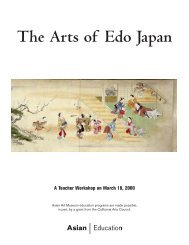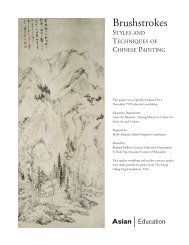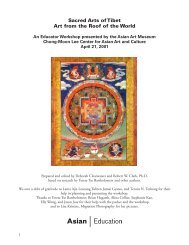Download PDF (free) - Asian Art Museum | Education
Download PDF (free) - Asian Art Museum | Education
Download PDF (free) - Asian Art Museum | Education
Create successful ePaper yourself
Turn your PDF publications into a flip-book with our unique Google optimized e-Paper software.
Decline of Ukiyo-e<br />
The technology and artistry of ukiyo-e peaked between 1750-1850. After this time,<br />
craftsmanship gradually declined due to rising production costs. With decreasing<br />
market demand, publishers concentrated on print runs that could be produced as<br />
cheaply as possible for the least discriminating of buyers. Repetitious designs and the<br />
use of aniline dyes, instead of vegetable pigments, signaled the end of this art form.<br />
Towards the end of the nineteenth century, ukiyo-e had more or less ceased to exist,<br />
as other graphic techniques such as photography and lithography gained momentum.<br />
While ukiyo-e declined in Japan, Western artists were “discovering” Japanese<br />
woodblock prints in the mid-nineteenth century and hailed them as artistic<br />
masterpieces. By the 1870s, many European scholars and artists were seriously<br />
studying Japanese art. Ukiyo-e prints had a particular impact on the works of<br />
progressive painters (especially the Impressionists), such as Edgar Degas, Claude<br />
Monet, Edouard Manet, Vincent van Gogh, and James McNeill Whistler. Western<br />
painters were struck by the brilliant, solid colors of Japanese prints, their simplified<br />
contour outlines, and flat asymmetrical compositions with little illusionary space.<br />
<strong>Art</strong>ists experimented with flattening planes in their compositions and brightening<br />
their palettes, which eventually helped form a modern abstract style.<br />
THE ART OF PRINTING<br />
In order that ukiyo-e prints feature the latest favorites of a discerning public, prints<br />
had to be published very quickly. Publication was a complex process involving the<br />
collaboration of several people: publisher, artist, carver, and printer. Publishers were<br />
the key figures in the printing process from start to finish: assessing the market,<br />
hiring the designer, supervising production, and arranging for distribution. It was<br />
the publisher’s seal that appeared on each print, with the artist’s signature. The only<br />
other person who had a say in production was the government censor, who checked<br />
all designs to make sure they were neither immoral nor politically subversive.<br />
After a publisher had decided upon the subject matter for a print or series of<br />
prints, he commissioned an artist to create the design. The artist would draw his<br />
composition in black ink on a thin sheet of paper. Although the artist might include<br />
notes and directions on his drawing, he was not involved in the printing process.<br />
This could sometimes lead to the artist’s dissatisfaction with the finished product,<br />
due to unexpected changes made by the printer or engraver. Hokusai apparently<br />
complained during the production of his volume of sketches (Hokusai Manga) that<br />
the engraver had added facial details and carved noses too much like those found in<br />
the prints of his contemporary, Utagawa Toyokuni (Williams, p. 3).<br />
The artist’s drawing was then sent to the printer’s workshop, where it was pasted face<br />
down on a block of smooth cherrywood. Oil was sometimes applied to the paper to<br />
make the outlines more visible. The paper was then pulled away (Japanese paper was<br />
very strong and fibrous) to leave a thin layer behind with the design outlines showing<br />
through.<br />
<strong>Asian</strong> <strong>Art</strong> <strong>Museum</strong><br />
10<br />
<strong>Education</strong> Department
















